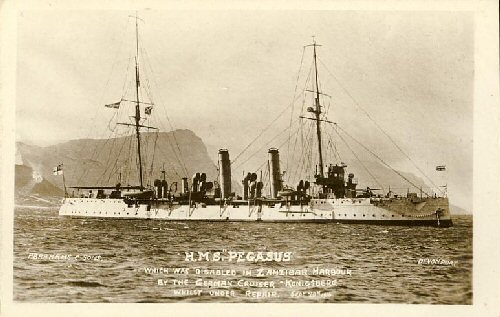
Caught Fire and Sunk 20 September 1914
HMS PEGASUS, BUILT BY PALMER, LAUNCHED 4/3/1897, SUNK BY KONIGSBERG, WHILST UNDER REPAIR, 20/9/1914.
SMS Königsberg (Commander Max Looff) was based at Dar es Salaam capital of German East Africa in June 1914. British naval forces in the area were the pre 1900 cruisers HMS Astraea, HMS Hyacinth and HMS PEGASUS under the command of Rear-Admiral King-Hall. On August 6, two days after the outbreak of WW1, Königsberg captured the City of Winchester in the Gulf of Aden and scuttled it five days later having removed coal and supplies. The first British Merchant ship casualty of the war. Two days later HMS Astraea attacked Dar es Salaam destroying the wireless station and damaging port facilities but more importantly the Harbour Master panicked and sank a dry dock across the entrance blocking in a number of merchant vessels except the collier Somali which had sailed earlier. Königsberg coaled from Somali until supplies ran out after which she took refuge five miles up the Rufiji River delta to await a further consignment. Meanwhile HMS PEGASUS put in to Zanzibar to overhaul her boilers, news of which was relayed to Königsberg. On 19 September she left her lair and sailed for Zanzibar where early the following morning she sighted the armed tug Helmuth patrolling the harbour. Königsberg fired two rounds to scare off the tug and then at 11,000 yards opened fire on the stationary HMS PEGASUS. Although HMS PEGASUS returned fire the battle was over within forty five minutes. HMS PEGASUS caught fire and sank later that day with the loss of 38 lives and 55 wounded.
Soon after the short battle at Zanzibar, a story reached the press that the naval ensign for Pegasus had been shot away during the firing but was then held aloft by Royal Marines who heroically ran out into the rain of shell fire to keep their flag flying. In reality Captain Ingles of Pegasus had ordered the ensign struck and a white flag raised in order to prevent further loss to his crew. The unpleasant fact that a British man of war had struck her colours was never endorsed during the war and the story of the brave marines continued to inspire accounts and paintings for years afterward